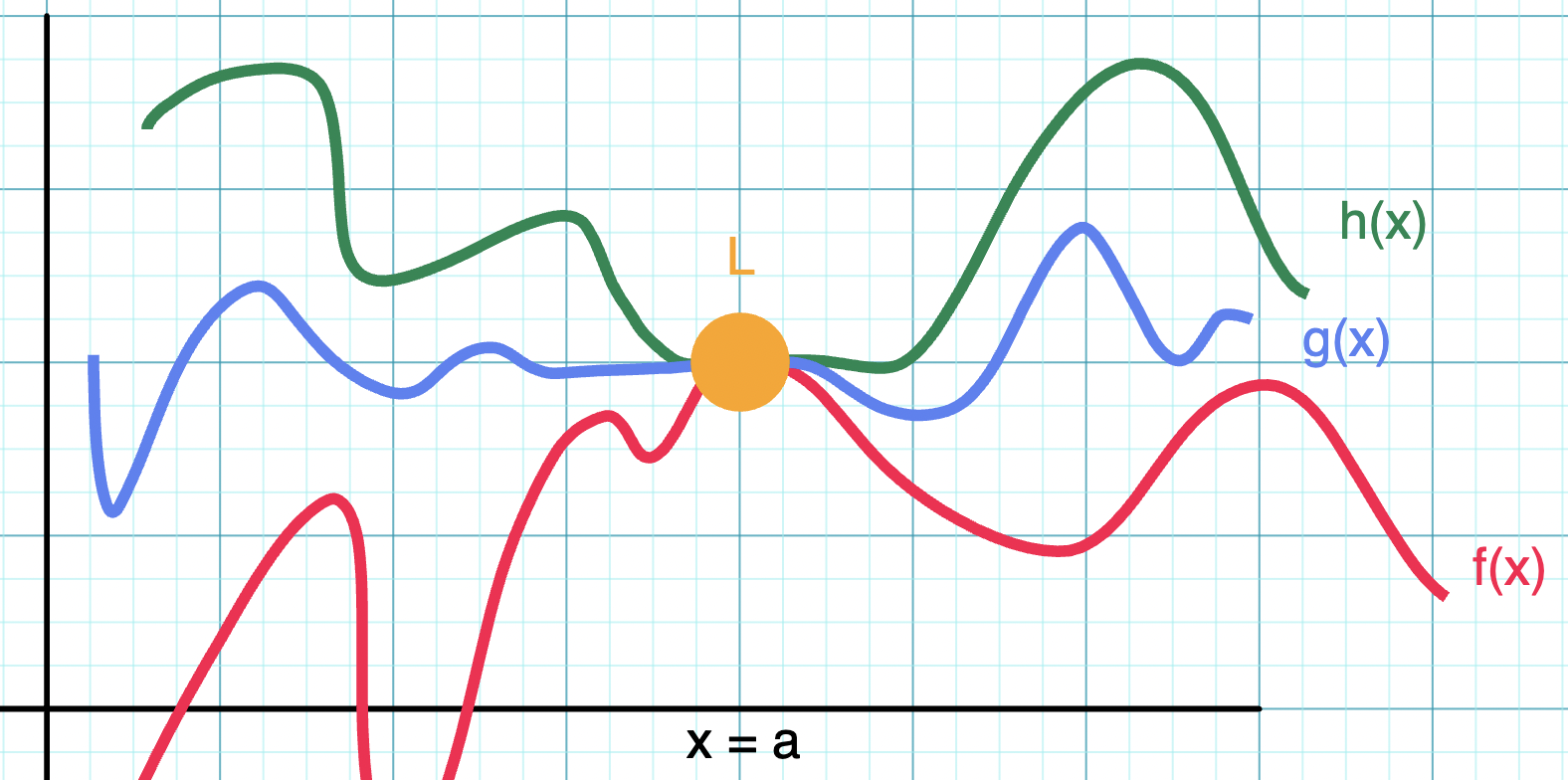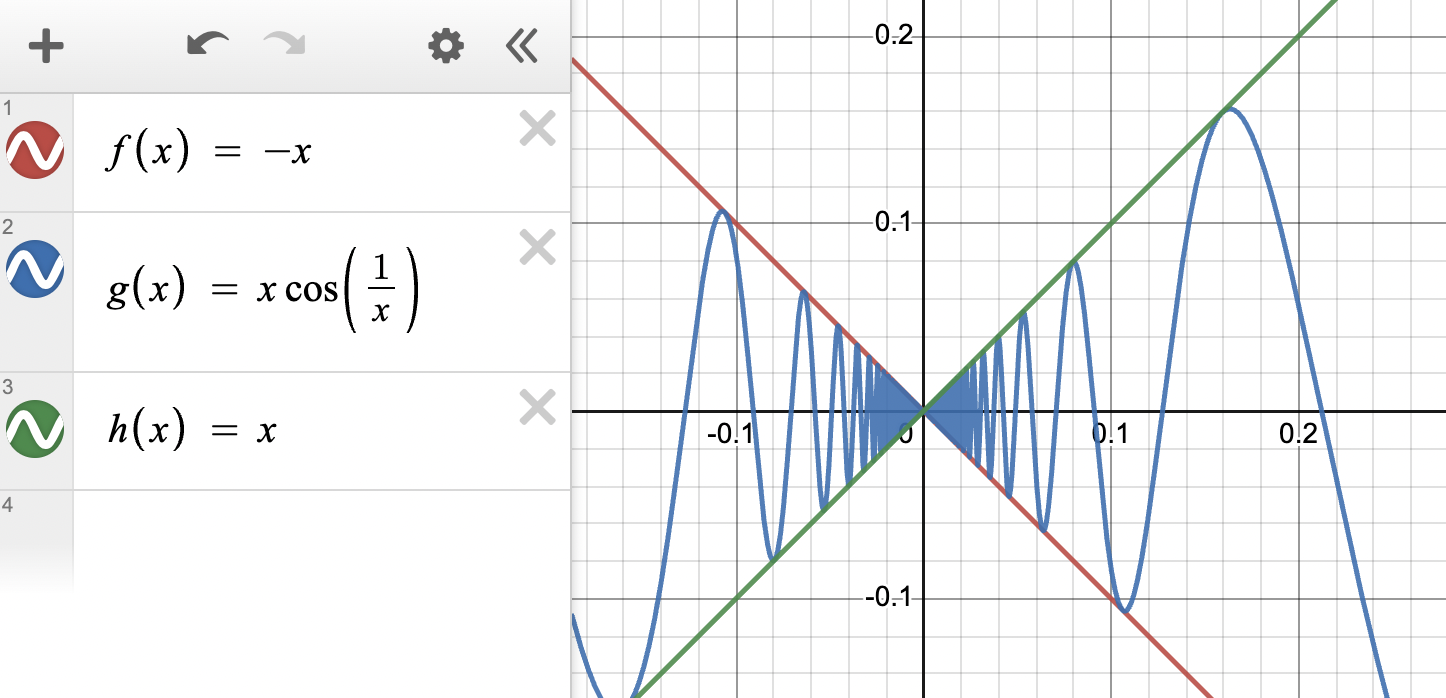You have 3 free guides left 😟
Unlock your guides1.8 Determining Limits Using the Squeeze Theorem
4 min read•june 18, 2024
1.8 Determining Limits Using the Squeeze Theorem
Welcome back to AP Calculus with Fiveable! This topic focuses on determining the of a based on information given about other functions that bound it. We’ve worked through determining limits through algebraic manipulation, graphs, and tables, so let's keep building our limit skills. 🙌
⌛ Squeeze Theorem
Before we get into the nitty gritty, be sure to review some of the content we’ve already went over!
📚 Background Knowledge
To effectively use the , you should be familiar with:
- Limits: Understanding how functions behave near a specific value.
- Basic Function Behavior: Knowledge about how functions like sine, cosine, exponential, etc., behave for different inputs.
🧩 What is the Squeeze Theorem?
The squeeze theorem states that if and , then must also . Take a look at the visual below!

Graph representing squeeze theorem
Graph drawn using Virtual Graph Paper
We can see that the function is sandwiched between and , so it must follow the same rule in the shown interval.
🧮 Squeeze Theorem Practice Problems
Let’s work on a few questions and make sure we have the concept down!
1) Squeeze Theorem Logic
Functions and are twice-differentiable functions with It is known that for . Let k be a function satisfying for
. Is continuous at ? Justify your answer.
Once you’re ready, keep on reading to see how to approach this question. ⬇️
If functions and are twice-differentiable, they must be continuous. Therefore, and . Since and the conditions for continuity are met, the squeeze theorem for applies at . So, .
Since , must equal .
We can then conclude that is continuous at because . Brush up on continuity rules with this guide here: Confirming Continuity Over an Interval.
This question is from the 2019 AP Calculus AB examination administered by College Board. All credit to College Board. Way to go! 👏
2) Computing a Limit Using Squeeze Theorem
Find the limit of the function as 0, using the Squeeze Theorem.
In this case, we can use the fact that for all to create a bounding function.
Multiply the inequality by , and then consider the bounding functions and so that .
Since , and the functions are known to be continuous, the Squeeze Theorem can be applied. Let’s check the limits of the bounding functions as they approach 0 to see if they squeeze at .
Because , the Squeeze Theorem holds true, and…
Check out the graph below to confirm our answer visually!

Graph proving by the Squeeze Theorem
Graph created with Desmos
You nailed it! This was a tough one. 💪
🌟 Closing
Great work! 🙌 The squeeze theorem is a key foundational idea for AP Calculus. You can anticipate encountering questions involving limits and the squeeze theorem on the exam, both in multiple-choice and as part of a free response.

Encouraging GIF with animated ice cream
Image Courtesy of Giphy
If you’d like some steps to follow, here they are:
- 🤔 Identifying the Function: Recognize the function for which you need to determine the limit.
- 👀 Finding the 'Squeeze' Functions: Locate two functions that 'squeeze' the given function between them.
- 🏁 Ensuring Known Limits: Confirm that the limits of the 'squeezing' functions are known as x approaches the same value.
You got this! 🤩
© 2024 Fiveable Inc. All rights reserved.
AP® and SAT® are trademarks registered by the College Board, which is not affiliated with, and does not endorse this website.
